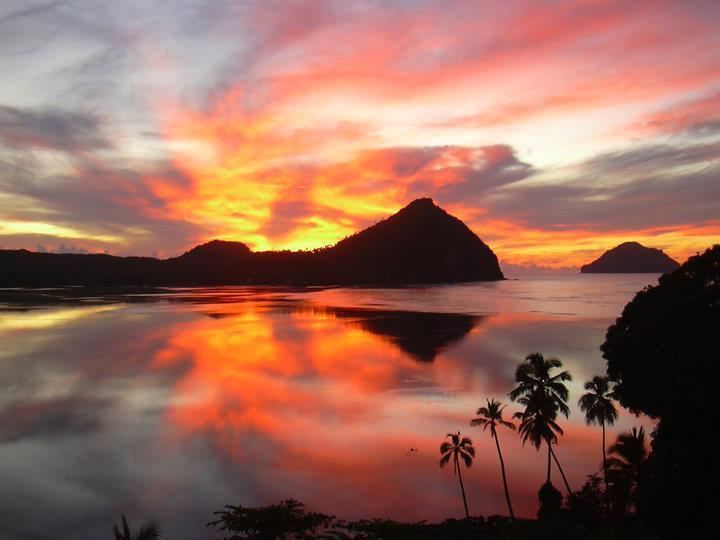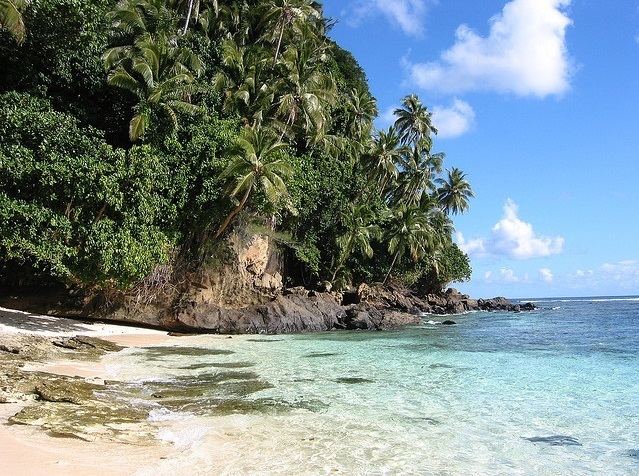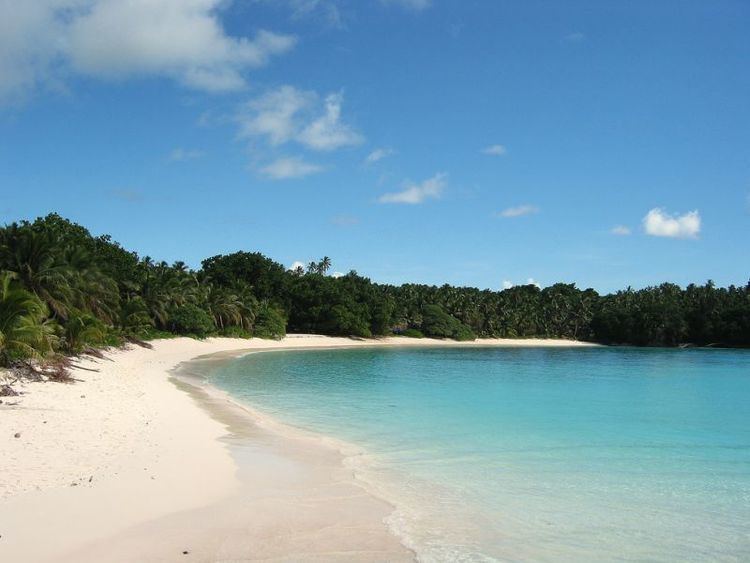Area - Total46 km218 sq mi | Population - 2007 census2,002 | |
 | ||
Map of Rotuma
Rotuma is a Fijian dependency, consisting of Rotuma Island and nearby islets. The island group is home to a large and unique indigenous ethnic group which constitutes a recognisable minority within the population of Fiji, known as "Rotumans". Its population at the 2007 census was 2,002, although many more Rotumans live on mainland Fijian islands, totaling 10,000.
Contents
- Map of Rotuma
- Drive around rotuma rotuma lakol ak video by fijisurfshots com
- Part 3 of 3 salat se rotuma passage to rotuma a beautiful remote island in the pacific
- Geography and geology
- Flora and fauna
- Linguistic evidence
- Origins in oral history
- European contact
- Mid 19th century
- Cession to Britain
- Demographics
- Notable Rotumans and people of Rotuman descent
- Politics and society
- Social organization
- Political organization
- Social control
- Conflict
- Delicious cassava cake
- References

Drive around rotuma rotuma lakol ak video by fijisurfshots com
Part 3 of 3 salat se rotuma passage to rotuma a beautiful remote island in the pacific
Geography and geology

These volcanic islands are located 646 kilometres (401 mi) (Suva to Ahau) north of Fiji. Rotuma Island itself is 13 kilometres (8.1 mi) long and 4 kilometres (2.5 mi) wide, with a land area of approximately 43 square kilometres (11,000 acres), making it the 12th largest island of Fiji. The island is bisected into a larger eastern part, and a western peninsula, by a low narrow isthmus only 230 metres (750 ft) wide, the location of Motusa village (Itu'ti'u district). North of the isthmus is Maka Bay, and in the south Hapmafau Bay. There are a large population of coral reefs in these bays, through which there are boat passages.

Rotuma is a shield volcano made of alkali-olivine basalt and hawaiite, with many small cones, and reaches 256 metres (840 ft) above sea level at Mount Suelhof near the center of the island. Satarua Peak, 166 metres (540 ft) high, lies near the eastern end of the island. While very secluded from much of Fiji proper, the large reef and untouched beaches are renowned as some of the most beautiful in all of Fiji.
There are some islands located at a distance between 50 metres (160 ft) and 2 kilometres (1.2 mi) from the main island, but still within the fringing reef:
Additionally, there is a separate chain of islands between 3 kilometres (1.9 mi) and 6 kilometres (3.7 mi) northwest and west of the westernmost point of Rotuma Island. From northeast to southwest, are:
The geological features of this unique island contribute to its national significance as outlined in Fiji's Biodiversity Strategy and Action Plan.
Flora and fauna
A 4,200 hectares (10,000 acres) area covering the main island and its small satellite islets is the Rotuma Important Bird Area. The Important Bird Area area covers the entire range of the vulnerable Rotuma myzomela, and the Rotuman subspecies of Polynesian starling and Lesser Shrikebill. Rotuma also supports isolated outlying populations of Crimson-crowned fruit dove and Polynesian triller. The offshore islets of Ha’atana, Hofliua and Hatawa have nationally significant seabird colonies.
Linguistic evidence
Linguistic evidence suggests an original settlement from Fiji. Linguists include the Rotuman language in a subgroup with the languages of western Fiji, but Rotuman also has a large number of Polynesian loanwords, indicating later contact with Samoa and Tonga.
Origins in oral history
Rotuman oral history indicates that the islands' first inhabitants came from Samoa, whence they were led by a man named Raho. Shortly thereafter, further settlers arrived from Tonga. Later, additional settlers came from Tonga and Kiribati. In the 1850s and 1860s, Tongan Prince Ma'afu claimed Rotuma and sent subordinates to administer the main island and islets.
Ratzel wrote about a legend relating to the Samoans and Rotuma as follows:
"Thus the Samoans relate that one of their chiefs fished up Rotuma and planted coco-palm on it. But in a later migration the chief Tokaniua came that way with a canoe full of men and quarrelled with him about the prior right of possession."
European contact
The first known European sighting of Rotuma was in 1791, when Captain Edward Edwards and the crew of HMS Pandora landed in search of sailors who had disappeared following the Mutiny on the Bounty. There has been some argument whether the island discovered by Quirós known as Tuamaco fits the description and location of Rotuma, but no claim has been fully substantiated.
Mid-19th century
A favorite of whaling ships in need of reprovisioning, in the mid-nineteenth century Rotuma became a haven for runaway sailors, some of whom were escaped convicts. Some of these deserters married local women and contributed their genes to an already heterogeneous pool; others met violent ends, reportedly at one another's hands. Rotuma was visited as part of the United States Exploring Expedition in 1840.
Cession to Britain
Wesleyan missionaries from Tonga arrived on Rotuma in 1842, followed by Catholic Marists in 1847. Conflicts between the two groups, fuelled by previous political rivalries among the chiefs of Rotuma's seven districts, resulted in hostilities that led the local chiefs in 1879 to ask Britain to annex the island group. On 13 May 1881, Rotuma was officially ceded to the United Kingdom, seven years after Fiji became a colony. The event is annually celebrated as Rotuma Day.
Demographics
Although the island has been politically part of Fiji since 1881, Rotuman culture more closely resembles that of the Polynesian islands to the east, most noticeably Tonga, Samoa, Futuna, and Uvea. Because of their Polynesian appearance and distinctive language, Rotumans now constitute a recognizable minority group within the Republic of Fiji. The great majority of Rotumans (9,984 according to the 2007 Fiji census) now live elsewhere in Fiji, with 1,953 Rotumans remaining on Rotuma. Rotumans are culturally conservative and maintain their customs in the face of changes brought about by increased contact with the outside world. As recently as 1985, some 85 percent of Rotumans voted against opening the island up to tourism, wary of the influence of Western tourists. P&O Cruises landed on the island twice in the 1980s.
Notable Rotumans and people of Rotuman descent
Politics and society
Rotuma was governed as an integral part of the Colony of Fiji after cession to the United Kingdom in 1881 when a group of Rotuman chiefs travelled to London to meet Queen Victoria. The Paramount chief was granted the name of Albert by the Queen in honour of her husband Prince Albert who had died twenty years earlier.
Following Fiji's Independence in 1970 and the military coups of 1987, Rotuma remained with Fiji.
Social organization
Rotuma is divided into seven autonomous districts, each with its own headman or chief (Gagaj 'es Itu'u), with villages:
- Noa'tau (extreme southeast): Fekeioko, Maragte'u, Faf'iasina, Matu'ea, 'Ut'utu, Kalvaka
- Oinafa (east): Oinafa, Lopta, Paptea
- Itu'ti'u (west, but east of western peninsula): Savlei, Lạu, Feavại, Tuạ'koi, Motusa, Hapmak, Losa, Fapufa, Ahạu (Government Station)
- Malha'a (north): Pepheua, 'Else'e, 'Elsio
- Juju (south): Tuại, Haga, Juju
- Pepjei (southeast): 'Ujia, Uạnheta, Avave
- Itu'muta (western peninsula): Maftoa, Lopo
The district chiefs and elected district representatives make up the Rotuma Island Council . The districts are divided into subgroupings of households (ho'aga) that function as work groups under the leadership of a subchief (gagaj 'es ho'aga). All district headmen and the majority of ho'aga headmen are titled. In addition, some men hold titles without headship (as tög), although they are expected to exercise leadership roles in support of the district headman. Titles, which are held for life, belong to specified house sites (fuạg ri). All the descendents of previous occupants of a fuạg ri have a right to participate in the selection of successors to titles.
On formal occasions titled men and dignitaries such as ministers and priests, government officials, and distinguished visitors occupy a place of honor. They are ceremonially served food from special baskets and kava. In the daily routine of Village life, however, they are not especially privileged. As yet no significant class distinctions based on wealth or control of resources have emerged, but investments in elaborate housing and motor vehicles by a few families have led to visible differences in standard of living.
Political organization
At the time of discovery by Europeans there were three pan-Rotuman political positions: the fakpure, the sạu, and the mua. The fakpure acted as convener and presiding officer over the council of district headmen and was responsible for appointing the sạu and ensuring that he was cared for properly. The fakpure was headman of the District that headed the alliance that had won the last war. The sạu's role was to take part in the ritual cycle, oriented toward ensuring prosperity, as an object of veneration. Early European visitors referred to the sạu as "king," but he actually had no secular power. The position of sạu was supposed to rotate between districts, and a breach of this custom was considered to be incitement to war. The role of mua is more obscure, but like the sạu, he was an active participant in the ritual cycle. According to some accounts the mua acted as a kind of high priest.
Following Christianization in the 1860s, the offices of sạu and mua were terminated. Colonial administration involved the appointment by the governor of Fiji of a Resident Commissioner (after 1935, a District Officer) to Rotuma. He was advised by a council composed of the district chiefs. In 1940 the council was expanded to include an elected representative from each district and the Assistant Medical Practitioner. Following Fiji's independence in 1970, the council assumed responsibility for the internal governance of Rotuma, with the District Officer assigned to an advisory role. Up until the first coup, Rotuma was represented in the Fiji legislature by a single senator.
Administratively, Rotuma is fully incorporated into Fiji, but with local government so tailored as to give the island a measure of autonomy greater than that enjoyed by other political subdivisions of Fiji. Rotuma has the status of a Dependency, and its administrative capital is 'Ahạu in the district of Itu'ti'u, where the "tariạgsạu" (traditionally the name of the sạu's palace) meeting house for the Council of Rotuma is based.
At the national level, Fijian citizens of Rotuman descent elect one representative to the Fijian House of Representatives, and the Council of Rotuma nominates one representative to the Fijian Senate. Rotuma is also represented in the influential Great Council of Chiefs by three representatives chosen by the Council of Rotuma. For electoral purposes, Rotumans were formerly classified as Fijians, but when the Constitution was revised in 1997-1998, they were granted separate representation at their own request. (The majority of seats in Fiji's House of Representatives are allocated on a communal basis to Fiji's various ethnic groups) In addition, Rotuma forms part (along with Taveuni and the Lau Islands) of the Lau Taveuni Rotuma Open Constituency, one of 25 constituencies whose representatives are chosen by universal suffrage.
Social control
The ho'aga, a kinship community, was the basic residential unit in pre-contact Rotuma. The basis for social control is a strong socialization emphasis on social responsibility and a sensitivity to shaming. Gossip serves as a mechanism for sanctioning deviation, but the most powerful deterrent to antisocial behavior is an abiding belief in imminent justice, that supernatural forces (the 'atua or ghosts of ancestors) will punish wrongdoing. Rotumans are a rather gentle people; violence is extremely rare and serious crimes nearly nonexistent.
Conflict
Prior to cession, warfare, though conducted on a modest scale, was endemic in Rotuma. During the colonial era political rivalries were muted, since power was concentrated in the offices of Resident Commissioner and District Officer. Following Fiji's independence, however, interdistrict rivalries were again given expression, now in the form of Political contention. Following the second coup, when Fiji left the British Commonwealth of Nations, a segment of the Rotuman population, known as the "Mölmahao Clan" of Noa’tau rejected the council's decision to remain with the newly declared republic. Arguing that Rotuma had been ceded to the United Kingdom and not to Fiji, these rebels declared in 1987 independence of Republic of Rotuma and were charged with sedition. It did not have any substantive support, majority opinion appears to favor remaining with Fiji, but rumblings of discontent remain.
